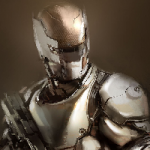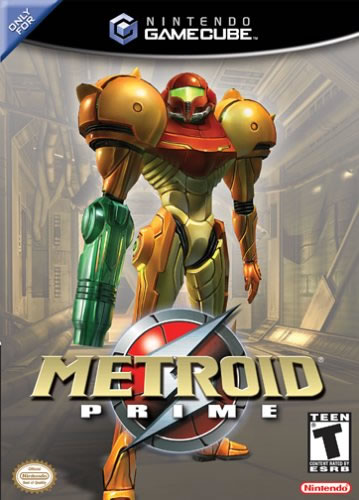 Review by: Asaic
Review by: Asaic
Original Publish Date: Pending
Final rating: As a Metroid sequel: 6/10
As a stand-alone game: 8.5/10
 It has been nearly nine years! The galaxy has been at peace for too long. But as of November of 2002, that has finally changed. The Metroid menace has once again been unleashed, and we couldn’t be happier.
It has been nearly nine years! The galaxy has been at peace for too long. But as of November of 2002, that has finally changed. The Metroid menace has once again been unleashed, and we couldn’t be happier.
As a game all to itself, Metroid Prime is excellent. It has the polish and appeal that many high-status games tend to boast. But as a sequel to the Metroid games, I can’t give it nearly as much praise. It is missing a lot of the things I’ve come to expect from the Metroid series. Fortunately, it seems to make up for that in other ways.
For the record, Metroid Prime is not a typical first-person shooter. Nintendo has labeled it as a “first-person adventure”, and that couldn’t be more accurate. You do far more exploring and examining than shooting, so labeling it as a first-person shooter is simply misleading. It is an adventure, after all.
Control
While I’m glad that Retro didn’t give Prime the typical dual-analogue first-person-shooter control setup, I still don’t think that the controls were laid out as well as they could have been. On the plus side, the control layout that you’re forced to use isn’t horrible. If it were my design, I would have made a couple of changes, namely swapping X and Z and swapping A and B. Nothing that a custom control setup wouldn’t solve. But what we’re given still works, and while never feeling completely natural, it’s intuitive enough that you’re not going to make a lot of mistakes.
I would have added a couple of features, however. First of all, this game could seriously use a quick-turn button. The nature of the combat just screams for this. The turning is too slow and your field of vision is extremely limited. Second, there needs to be some way to lunge. And not just to the side like the dodging, but forward and backward as well. When locked onto an enemy, you can tap B while pressing left or right on the analogue stick to dodge. The problem is that you have to barely tap B to dodge, otherwise you do a full jump. This became rather troublesome. I would rather have it as a double-tap of the analogue stick.
But those are just dreams. As they are, the controls work well enough.
Gameplay
The gameplay has its ups and downs. Some of the better aspects are the lock-on system, the AI, the visors and the jumping. They really lend to making the game a fun experience.
Unfortunately, there are also some problems. The first-person view itself is bothersome. This isn’t a first-person-shooter, nor does it control like one. So why is it from a first-person view? Exploration could have been handled just as well from a third-person perspective, leaving the first-person view as a visor-only deal. Look at games like MegaMan Legends. With Nintendo’s famous precision controls, Metroid could have been amazing in that format. A third-person view would have allowed for true space jumping and the use of Screw Attack. It also would have allowed for faster and easier exploration due to the expanded range of sight.
Another big gameplay complaint is about the laggy weapons. Shots like the ice beam travel too slowly through the air and force you to fight up close, which is the opposite of what you want in a first-person perspective. With the enemy right in your face, you can’t tell what else is going on in that room, including the movement of the other enemies. Missiles have a terrible firing rate. They don’t need to be rapid-fire, but a two-second wait between shots is excruciating in the heat of combat. And the biggest problem is the time it takes to switch between beams or from missiles back to your beam. With the necessity of constantly switching beams during combat later in the game, this really puts a damper on the pacing.
However, the game still manages to be fun to play. Retro did a great job despite having so many unnecessary limitations. I can only imagine how amazing this game would have been had it been third-person with a customizable button configuration and a couple more moves!
Graphics
The graphics are very impressive. From reflections to lighting to water effects, there is certainly a lot of eye candy here. The textures tend to be a little repetitive, but not overly so. The models appear well detailed from afar, but up close they tend to be lacking the finer touches. The framerate is also a solid 60 frames-per-second from start to finish. My only real qualm with the graphics is that some areas of the game are just too dark, causing a lot of the jumping to become guesswork. While not without its flaws, Metroid Prime’s overall visual appeal is matched by few, and surpassed by even fewer.
Sound
Retro did a great job on the sound effects. They are crisp and clear and very distinctive. Though I have a Dolby Surround Pro-Logic system, I didn’t notice much of a surround effect. Sounds that were supposed to be behind me just didn’t sound like there were actually behind me. Switching to Dolby sound in the options menu does improve the sound quality, but it just doesn’t give the full surround experience I enjoy from other games and movies.
Music
The music was ultimately disappointing from a sequel standpoint. It wasn’t very nostalgic or memorable. Not a single tune from Prime sticks in my head, while all the other Metroid games (including Metroid Fusion) have many memorable tunes that I love listening to over and over. As a game by itself, the music in Prime is pretty good, though rather forgettable. As a Metroid title I found it especially lacking.
Lasting Appeal
Your first time through the game will take you anywhere from 8-20 hours, and that doesn’t include time spent reading logs and scan data. Subsequent plays will offer several hours each. Throw in two sets of 100% completion objectives, three endings and Hard Mode and you’ve got some decent replay potential. The downside is that it is not as much fun as the other Metroid games. I find that I have less desire to go back for additional trips through Tallon IV than Zebes, SR388 or the BSL research station.
Despite the lack of replayability, it is still a great game. Depending on how much you enjoy it, you may be compelled to replay it many times. Unfortunately, it didn’t offer much appeal for replayability to me compared to the other Metroid games. As a stand-alone game, it’s replay factor is better than average, but not up to Metroid standards.
Overall
As a game on its own, Metroid Prime is definitely an ‘A’ title. From its presentation to its lengthy quest, it has much to offer. It is far from perfect, but it still offers a better overall experience than most other games do. If you don’t yet own a Nintendo GameCube, this game may be all the reason you need to go out and get one.
However, if you’re looking for a great Metroid sequel, I’d recommend you try Metroid Fusion first. Prime felt the least “Metroid” of all the games, while Fusion was exactly what the doctor ordered. While it was nice to see a Metroid game from a first-person perspective, I wouldn’t want them to do it again. At the same time, Metroid Prime is a pretty good game in its own right. It’s definitely a title to consider picking up. But don’t buy it because it’s a Metroid game, buy it because it’s a good game, period.
Final Rating:
As a Metroid sequel: 6/10
As a stand-alone game: 8.5/10
